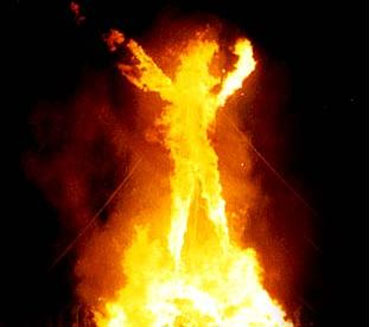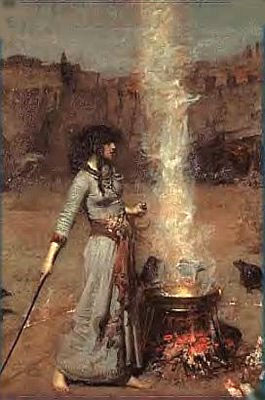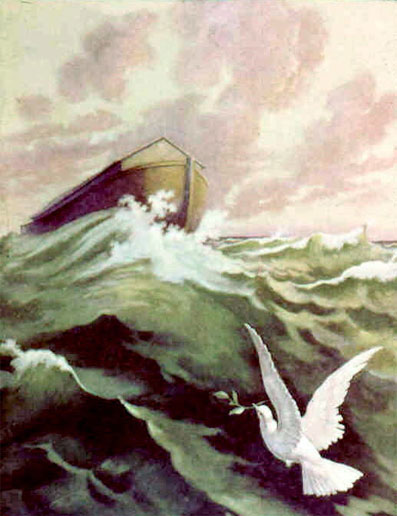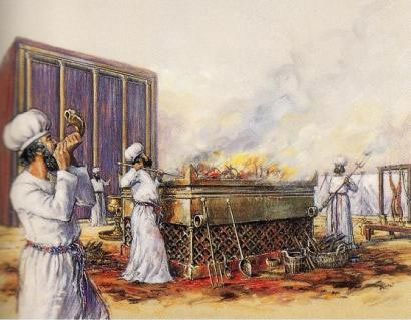Oct
8
2009
Evil Eve: The Harlotry of the First Century sons of Aaron
 The Lord “called” Adam as Day 1, giving him one law (light). He divided him as Day 2 and built Eve as a Holy Place, a firmament to be filled with stars (godly offspring). As Day 3 He made a new covenant and married them, the first nearbringing. Adam as the Bronze Altar (dust elevated from the Land) then became the first High Priest, the Table. In his obedience, together they prefigured totus Christus.
The Lord “called” Adam as Day 1, giving him one law (light). He divided him as Day 2 and built Eve as a Holy Place, a firmament to be filled with stars (godly offspring). As Day 3 He made a new covenant and married them, the first nearbringing. Adam as the Bronze Altar (dust elevated from the Land) then became the first High Priest, the Table. In his obedience, together they prefigured totus Christus.
Day 4 follows. As Adam represented singular light, Eve was plural light. She was the holy fire on the altar, the glory of Adam. [1] Day 4 is the Lampstand. Day 4 is also the wilderness. If Eve was seduced, it was because Adam’s priesthood was corrupt. There was strange fire on the altar, the biblical theme of harlotry. In the garden, the strange fire was the false lightbearer who filled the “firmament” with darkness.
With that background, look at how this plays out in Daniel 7. It also supports James Jordan’s assertion that the fact that the beast’s body is “feminine” carries some importance. [2] The false church is the body of totus diabolus, the locust swarm gathered as a tabernacle by the fallen head. Daniel seven is the history of the first century church as the Woman in the wilderness. But the faithfulness of the new Adam brought an end to the priesthood of the sons of Aaron.
Continue reading
Comments Off | tags: Altar, Daniel, Firstfruits, Herod, James Jordan, Lampstand, Tabernacle, Totus Diabolus | posted in Biblical Theology, The Last Days, Totus Christus
Oct
1
2009
More Thoughts on Prophetic Cauldrons
“Double, double toil and trouble
Fire burn, and cauldron bubble.”
Macbeth, Act 4, Scene 1

.
Two days ago, we saw the Lord take Jeremiah through the Creation/Tabernacle pattern as He anointed him. Here’s some more thoughts on the Babylonian “seething pot” using the Tabernacle pattern as a guide.
Usually, the Lampstand is at the centre of the passage (Pentecost). But the almond tree/Lampstand here is at Firstfruits. The Land of Day 3 is the Bronze Altar, but the grain and fruit (the Table) is replaced here by the almond).
Jeremiah, as a sign to Israel, is made the incarnation of Yahweh. The seven-eyed “watching tree” is actually Jeremiah, and the Lord continually asks him to “see.” As the prophetic Lampstand watched over Israel (the Table), so Jeremiah would watch over her destruction.[1] The Table seems to be covered by Nebuchadnezzar!
Continue reading
Comments Off | tags: Altar, Feasts, Jeremiah, Lampstand, Revelation, Tabernacle | posted in Biblical Theology, The Restoration Era
Jul
6
2009

If we don’t get Genesis right, we’ll get much of the Bible wrong. In Through New Eyes (PDF), James Jordan identifies a three-level “cosmos” in the Creation, which is reflected on the earth. There is the Garden Sanctuary, the Land of Eden, and the Outlying Lands, or Garden, Land and World.
This is reflected, not only in the ark of Noah, but also in the Tabernacle. The image is dual, one in heaven and one on earth:
Continue reading
Comments Off | tags: Against Hyperpreterism, Altar, Babel, oikoumene, Paul, Tabernacle | posted in Against Hyperpreterism, Biblical Theology, The Last Days
Apr
15
2009

See to it that you do not refuse him who speaks. If they did not escape when they refused him who warned them on earth, how much less will we, if we turn away from him who warns us from heaven? At that time his voice shook the Land, but now he has promised, “Once more I will shake not only the Land but also the heavens.” The words “once more” indicate the removing of what can be shaken—that is, created things—so that what cannot be shaken may remain. Therefore, since we are receiving a kingdom that cannot be shaken, let us be thankful, and so worship God acceptably with reverence and awe, for our “God is a consuming fire.” Hebrews 12:25-29
The context of Hebrews is AD70. The destruction of Jerusalem meant that the saints had received the kingdom (Daniel 7).
Continue reading
Comments Off | tags: AD70, Altar, Atonement, Azal, Hebrews, Jericho, Passover, Tabernacle | posted in Biblical Theology, The Last Days
 The Lord “called” Adam as Day 1, giving him one law (light). He divided him as Day 2 and built Eve as a Holy Place, a firmament to be filled with stars (godly offspring). As Day 3 He made a new covenant and married them, the first nearbringing. Adam as the Bronze Altar (dust elevated from the Land) then became the first High Priest, the Table. In his obedience, together they prefigured totus Christus.
The Lord “called” Adam as Day 1, giving him one law (light). He divided him as Day 2 and built Eve as a Holy Place, a firmament to be filled with stars (godly offspring). As Day 3 He made a new covenant and married them, the first nearbringing. Adam as the Bronze Altar (dust elevated from the Land) then became the first High Priest, the Table. In his obedience, together they prefigured totus Christus.



























